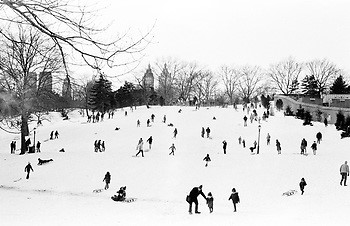The Earth in Cities
Livable Cities
Cities are not separate from the Earth. The Bois de Boulogne reveals the living Earth within Paris, France.
What makes cities habitable?
Once the countless ecosystems of the Earth — forests, meadows, rivers, lakes, oceans — surrounded the relatively small areas where Homo sapiens lived. Now the places we inhabit are subverting these ecosystems intrinsic to the Earth’s health and our well-being. Cities are bursting their government-prescribed boundaries. Suburbs are becoming a new kind of city. Rural areas with their remote villages are disappearing, encroached upon by ‘development.’
The air, water, and soils of planet Earth are where life as we know is made possible. These elements make up our nest, our Biosphere. It’s the only place where living systems like ourselves, other animals, plants, and insects can exist as functioning individual yet interdependent organisms. But our constructions are poisoning the Biosphere. At the same time, across our home planet, Indigenous communities are fighting to retain their unique relationships to the Earth that honor and respect the limits placed on their actions by the Biosphere. We have much to learn from their traditions.
The Biosphere is the source of our life-support systems. It nurtures the absolute necessities for our existence — the air we breathe, the water we drink, the soils that source the food we eat. We are experiencing the impacts of our ignoring this life foundation — the Covid-19 Pandemic and its variants at the microscopic level and the Climate Crisis at the global level.
The challenge we face is transforming our cities and other habitations to align with the Earth’s life-support systems.
Central Park, Manhattan Island, New York City, USA
Joel Greenberg, Copyright 1988
Urban Wilderness: Nature in New York City
Mention New York City and many people picture the Statue of Liberty, Times Square, the World Trade Center. Few see the magnificent natural environments of the Earth within the city with its swiftly flowing rivers and meandering streams, its extensive falling-leaf forests and stands of evergreen trees, and its expansive tidal and freshwater marshes. Still fewer know that within New York City live birds, butterflies, fish, frogs, lizards, snakes, turtles, and many mammals other than humans. A humpback whale has even been sighted in the city!
Extraordinary variety distinguishes the Earth within New York City. Despite a resident population of over 8.8. million, plus nearly a million more daily commuters, more than a fourth of the city remains land that is still the surface of the Earth. During the last three hundred years we dramatically restructured the land that New York City now occupies. These changes to the Earth to create the urban habitat we know today are equal in magnitude to earlier geological transformations. The human species had become a natural force as powerful as geological ones.
Yet the Earth visibly continues to function in the almost 50,000 acres set aside as parks within New York City. These areas offer unexpected and much needed opportunities to directly experience our life-support system – the Earth. People instinctively flocked to them during the Pandemic. Their bodies craved the regeneration the Earth gave them.
Many of us are creating more life-sustaining habits awakened by the Pandemic and the Climate Crisis. Let’s remember our experiences of rejuvenation when we experience the Earth directly. Let’s join together to support our life-sustaining planet – Our Home.
Urban Wilderness: Nature in New York City is “a remarkable and culturally rewarding project related to the presentation of the Natural Features of urban environments by means of a photographic survey of all of New York City.”


